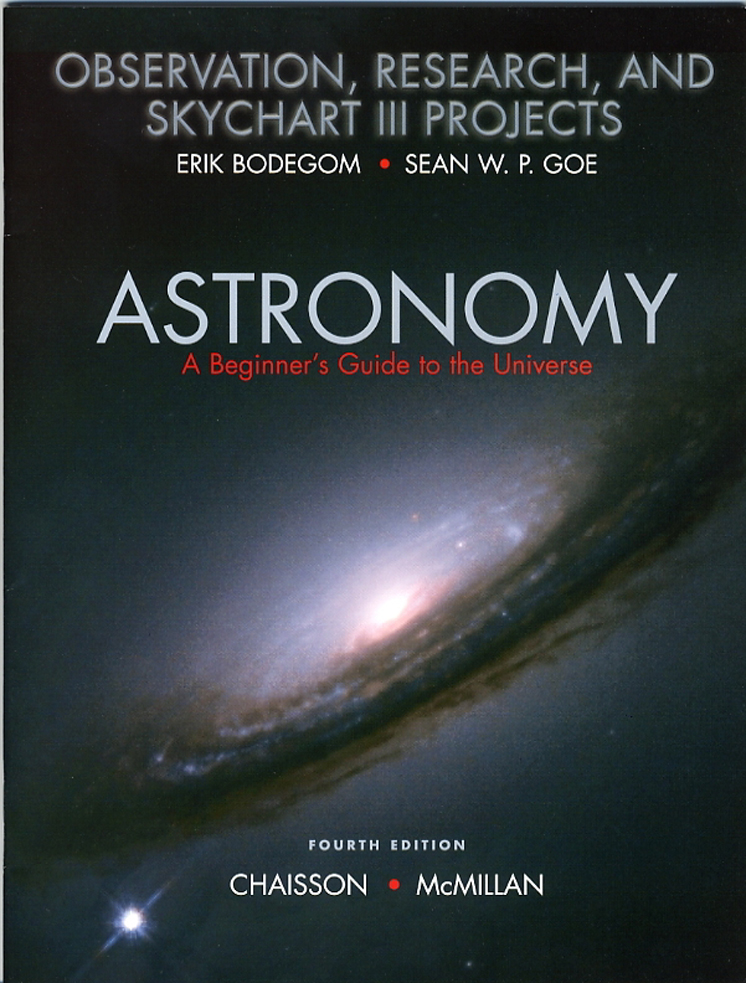Astronomy Exercises |
| In Oregon, the weather does not cooperate often to make observing possible. However, with modern computers one can do "real" observing using planetarium software. SkyChart III is the software program that comes bundled with "Astronomy: A Beginner's Guide to the Universe" by Chaisson and McMillan (Prentice Hall, 2004). The "observing" projects were written by Sean Goe and me. | ||
| The following is a sample project and some neat background information. | ||
| A Chapter
1 project:
The Mesopotamians
were well aware of the cycles of the heavens. Venus (the Star of Ishtar)
was symbolized by an eight-pointed star. It turns out there is a reason
for the number eight. Venus experiences a cycle of approximately eight
years. Venus is located at the same location with respect to the "fixed"
stars every eight years. In this time, it has switched back and forth
between morning and evening star five times. |
||
| From: Echoes of the Ancient Skies: The Astronomy of Lost Civilizations, by E.C. Krupp | ||
| Very
direct symbolism in the signs for the sun and the moon and in several
of the other symbols whose meaning is understood tempt a guess that the
symbolism in the Star of Ishtar is in some way equally direct. Perhaps
the number eight is itself symbolic, for Venus experiences an eight-year
cycle. During that time it passes through its complete evening star/morning
star/evening star pattern five times. This means that a configuration
of Venus recurs on the same solar calendar date after eight years, which
is how long five complete back-and-forth passes to either side of the
sun take. To establish the importance of this cycle we must verify that the Mesopotamians were familiar with it and made something special of it. In fact, we know they were well aware of it. Omen texts from the First Babylonian Dynasty (ca. 1900-1660 B.C.) confirm that the old Mesopotamian skywatchers understood that Venus as the morning star and as the evening star were the same thing. By the Seleucid period (ca. 301- 164 B.C.), we have a number of late goal-year texts in which the eight-year period was used to predict the appearances of Venus. These goal-year texts are clay tablets that list astronomical data for a given year and also for years specified by adding an appropriate number to the starting year. For Venus, the number to be added is eight. Accordingly, the pattern in the table for Venus will work for every eighth year from the year for which the table was prepared. For example, Professor Otto Neugebauer, one of the foremost historians of ancient science, described one of the Venus goal-year texts and showed that it provides dates and positions for Venus at last visibility as a morning star in steps of eight years. Another lists the planet's reappearance as an evening star over three eight-year intervals. Although the eight-year, five-cycle Venus period is close, it is not exact. After eight years, Venus is actually a little ahead of schedule, about 2.4 days. One text from the Neo-Babylonian period (626-539 B.C.), referring to Venus as Dilbat, records "Dilbat 8 years behind thee come back. . . 4 days thou shalt subtract." Here, the Mesopotamian planetwatcher is instructed to subtract four days to get the right date for Venus. This may appear to be an error, but it isn't. The 2.4-day correction applies to a solar calendar and the Mesopotamians kept their calendar by the moon. Because the moon arrived 1.6 days late, Venus configurations recurred four days early, and the Neo-Babylonian astronomers adjusted their predictions. Unfortunately, the goal-year texts are rather late and do not confirm that the eight-year cycle of Venus was known in Kassite times. We have, however, copies of a much earlier set of astronomical texts, the so-called tablets of Ammizaduga. Ammizaduga (or Ammi-saduqa) was the next to the last king of the First Babylonian Dynasty and probably ruled between 1650 and 1550 B.C. The exact dates are somewhat uncertain. Three decades after the end of his reign the Hittites deposed his successor, and somewhere in that period the Kassite Dynasty began. The original tablets of Ammizaduga probably were inscribed around 1700-1600 B.C., but they are long gone. Copies survived, however, in the library of the Assyrian king Ashurbanipal (668-626 B.C.) at Nineveh and are in the British Museum today. In them, 21 years of Venus data are given-dates of first and last appearances as a morning star and as an evening star and durations of invisibility-along with appropriate omens. If on the 25th of Tammuz Venus disappeared in the west, for 7 days remaining absent in the sky, and on the 2nd of Ab Venus was seen in the east, there will be rains in the land; desolation will be wrought. (year 8) Despite scribal
errors, the texts clearly exhibit the eight-year cycle and indicate
Mesopotamians in the middle of the second millennium B.C. were aware
of it. |
||
 |